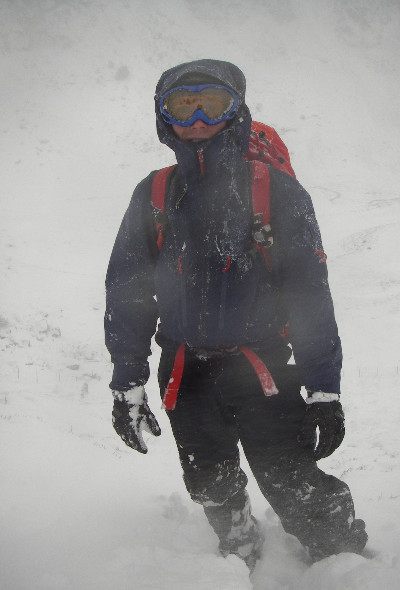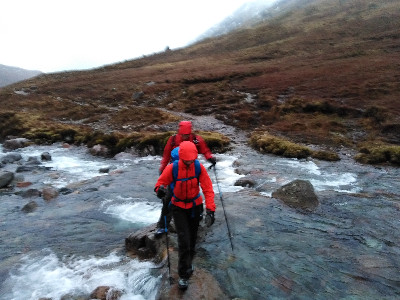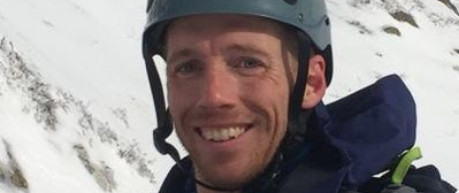AMI member Dave Slade gives advice on how to keep the cold at bay

A wise man once said: “There is no such thing as bad weather, just bad equipment.” And perhaps at some point that was true, but surly those days have passed? We now have jackets that ‘breathe’, layering systems that ‘wick’, and gloves that promise to keep you dry all day.
Yet walking across a wet Scottish mountain, feeling the water trickle down my legs knowing today would be another wet pants day, I wondered again, is it bad equipment or is it just that equipment has met its match in the Scottish weather?
Scottish winter climbing is the best in the world, however, with freezing levels at the base of the route, this can mean two hours of walking in the cold rain, only to stand still in the sleet while your mate inches up the first pitch. Your rucksack straps force water through your jacket, knees press against the melting snow, and all the while the wind blows slushy snow down your top. Are you warm enough?
While running a winter skills course, the weather was typically Scottish: wind and sleet with occasional snow. I vividly remember sitting down and eating my lunch, enjoying the feeling of being warm and comfortable in fairly horrible weather. Yet as I watched my group I noticed they were suffering: snow was blowing into open rucksacks, hoods were filling with snow, drinks bottles were frozen and a box of chicken salad was slowly turning to green slush.
A few winters ago, I had headed to climb a ridge line, with the freezing level just at the base of the route. It was heavy rain in the morning walk and the wind was wet. At the base of the route all three of us were soaked through and beginning to shiver. Enjoyment had departed and we were no longer warm enough, and I heard my own words coming back to me: “Any fool can be cold.”
I spend a lot of time on the hills in poor weather and have developed strategies to allow me to not just survive but sometimes even enjoy it. There are lots of things you can do to make sure you are warm enough, but the following are some of the key principals for me when working with others on the hills or cliffs.
The little things that can make a big difference:
Everyone has their view on which waterproof is the best and, yes, there is a difference between a £15 and a £150 jacket. However if you are walking or climbing in the pouring rain for hours do not expect your outer layer (no matter how good it is) to keep the rain out indefinitely, especially if it’s that ‘wet rain’ we get in Scotland.
So what you wear under your waterproof,it can be argued, is even more important. Wicking base layers combined with a fleece or synthetic insulated jacket is fairly common and works well even when wet. What is often missed is what you wear on your legs. Standard walking trousers have very little insulation properties once they are wet. Your waterproof outer layer, once saturated sticks to the now wet trousers and your thighs are then exposed almost directly to the wind. Instead of wearing standard cotton walking trousers try thick ‘wicking’ base layers or fleece trousers which are still warm even once they get wet. (Note: for most of us they don’t look great while walking to the café.)

If your feet get wet you will get grumpy.
There is a lot of information on which types of boots to use, but if you are getting wet through your boots then they are no longer up to the task you have set them. Even the right boot is no good if water goes down the top. In wet or snowy days a good fitting gaiter makes for a happier day. If you are walking in snow without wearing gaiters, the tops of your boots will fill with snow, which then melts and runs into your socks, and many of the integrated gaiters don’t cut it when ‘post holing’ into snow: a stand-alone gaiter is better. While walking in the ‘wet’ rain, or through wet heather, your over-trousers will leak at the bottom then proceed to trickle water into your socks, so wearing a gaiter can keep your feet much dryer.
How to seal it: Tuck your base trousers into your socks, gaiters on next over your base trousers before you put your waterproof trousers on top of your gaiters. Water outside, smells inside.
Not being able to do up your own zipper up because your hands are too cold is never a good look.
Again there is lots of information when it comes to gloves: read reviews, ask friends, try them out and carry extra pairs. However, the way you use your gloves is also important.
Firstly, if you don’t need your hands then tuck them away up your cuffs, and keep your gloves for when you need your hands. Once wearing gloves seal them to your jacket (jacket over the top) and don’t keep taking them on and off, instead find ways to keep them on: wear your watch on your rucksack, use a stylus to work your phone and eat food that you don’t need to lick your fingers after.
Carry a lightweight synthetic insulated jacket that you expect to put on once you’re at the base of the climb, near the summit of the hill, or as soon as you begin to get cold. Think of this more as your second coat, most wet Scottish days are a two coat day. This is in addition to what you may carry as an emergency or spare layer.
Sitting out for lunch is often not on the cards in poor weather, but don’t forget to eat. Chicken salads don’t make the best wet weather food, so instead try some high energy, fast to eat foods. If you are stopping for food then never sit on the ground, it is a “heat thief”. Stay standing or sit on your rucksack, put your back to the wind and put your hood up.
So are you warm enough?
Go out on low level walks in the really poor weather and try out your systems/clothing and equipment before you test it for real on the high hills. It only takes two to three hours to see if your new idea/equipment really works and this still leaves plenty of time to get to the gear shops or the cafe.
If you have to wait on the emergency services getting to you, will you be warm enough? Are you carrying enough equipment to make the wait not enjoyable, but at the very least survivable?
Don’t go on the hills without emergency survival bag/group shelter, extra insulated layer, sit mat, head torch, whistle, fully charged phone and extra food.
“Why would anyone go out in that?” The words from my wife as I head out the door in responding to a MRT call out. Some days are just cafe days. We go to the hills because we like it. Yes, sometimes optimism, the challenge of the weather or your last day off, drives you out on days when it is just horrible, but on these days strive to enjoy your day out by ensuring you are ‘warm enough’. Remember: “Any fool can be cold.”
Dave Slade is a Winter Mountaineering and Climbing Instructor based on the East coast of Scotland. He is forever optimistic about the weather and conditions, hence has had many ‘wet pants days’. Dave is married to Lisa and they have three children. He is a member of Tayside Mountain Rescue Team, works for the Ancrum Outdoor Centre and freelances throughout the UK.
He can be contacted at davesladeadventure@gmail.com or via www.ancrum.com
Association of Mountaineering Instructors
The Association of Mountaineering Instructors (AMI) is the representative body for professionally qualified Mountaineering Instructors in the UK and Ireland.
AMI members are highly experienced mountaineers who have undergone rigorous training and assessment to qualify under the Mountain Training UK (MTUK) Mountaineering Instructor scheme. AMI is committed to promoting good practice in all mountaineering instruction. By employing an AMI member you will be in the very best of hands. Look for the AMI logo as assurance of high quality instruction. www.ami.org.uk
